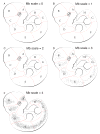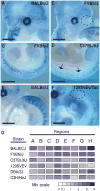Comparison of melanoblast expression patterns identifies distinct classes of genes
- PMID: 19493314
- PMCID: PMC3007121
- DOI: 10.1111/j.1755-148X.2009.00584.x
Comparison of melanoblast expression patterns identifies distinct classes of genes
Abstract
A full understanding of transcriptional regulation requires integration of information obtained from multiple experimental datasets. These include datasets annotating gene expression within the context of an entire organism under normal and genetically perturbed conditions. Here we describe an expression dataset annotating pigment cell-expressed genes of the developing melanocyte and retinal pigmented epithelium lineages. Expression images are annotated and available at http://research.nhgri.nih.gov/manuscripts/Loftus/March2009/. Data are also summarized in a standardized manner using a universal melanoblast scoring scale that accounts for the embryonic location of cells and regional cell density. This approach allowed us to classify 14 pigment genes into four groupings classified by cell lineage expression, temporal-spatial context, and differential alteration in response to altered MITF and SOX10 status. Significant differences in regional populations were also observed across inbred strain backgrounds, highlighting the value of this approach to identify modifier allele influences on melanoblast number and distributions. This analysis revealed novel features of in vivo expression patterns that are not measurable by in vitro-based assays, providing data that in combination with genomic analyses will allow modeling of pigment cell gene expression in development and disease.
Figures





References
-
- Amiel J, Watkin PM, Tassabehji M, Read AP, Winter RM. Mutation of the MITF gene in albinism-deafness syndrome (Tietz syndrome) Clin Dysmorphol. 1998;7:17–20. - PubMed
-
- Asher JH, Jr, Harrison RW, Morell R, Carey ML, Friedman TB. Effects of Pax3 modifier genes on craniofacial morphology, pigmentation, and viability: a murine model of Waardenburg syndrome variation. Genomics. 1996;34:285–298. - PubMed
-
- Baxter LL, Hou L, Loftus SK, Pavan WJ. Spotlight on spotted mice: a review of white spotting mouse mutants and associated human pigmentation disorders. Pigment Cell Res. 2004;17:215–224. - PubMed
-
- Baxter LL, Pavan WJ. The oculocutaneous albinism type IV gene Matp is a new marker of pigment cell precursors during mouse embryonic development. Mech Dev. 2002;116:209–212. - PubMed
-
- Baxter LL, Pavan WJ. Pmel17 expression is Mitf-dependent and reveals cranial melanoblast migration during murine development. Gene Expr Patterns. 2003;3:703–707. - PubMed
Publication types
MeSH terms
Substances
Grants and funding
LinkOut - more resources
Full Text Sources
Medical
Molecular Biology Databases

